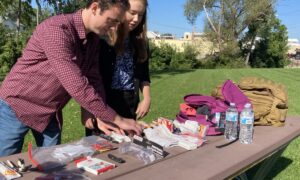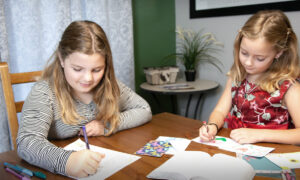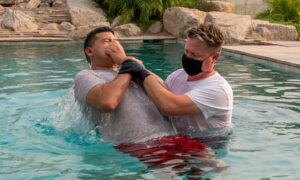By Awake! correspondent in Japan
“We have no knowledge of what we should do. Panic would break out.” So said a meteorologist from Pakistan regarding the effect an earthquake would have in his land. In reality, few people know what to do in an earthquake. Nevertheless, the spate of disastrous earthquakes in this century has led to increased research about earthquake protection. “Awake!” has thus interviewed a number of researchers from different lands. Since their advice has proved to be remarkably similar, it is hoped that this information will be of use to readers in many lands.
“THERE was a rumbling,” recalls Michiko, “and then a tremendous jolt that seemed to throw our wooden house up in the air. The noise of things crashing down and dishes and glasses breaking terrified me more than anything else. Suddenly, our home was contorted and balancing precariously on its foundations.
“My mother did not panic. She calmly told us to change into outdoor clothes and collect the things that were important to us. She explained that it was only a matter of time before our home would be destroyed, so we were to abandon it and go to the hospital where my father was working.”
Michiko was just a girl of 12 when she experienced one of the greatest disasters of this century—the 1923 earthquake that reduced two thirds of Tokyo and the whole of Yokohama to ashes. Thousands of homes crumbled. And when the dust settled, over 143,000 were dead. Interestingly, though, a government report issued later stated: “Those who died because of their homes collapsing accounted for about one tenth” of the total fatalities. What, then, accounted for the other 130,000 deaths?
The earthquake had struck at two minutes to noon—a time when many housewives had started fires to prepare the midday meal. The result? Countless fires broke out in a matter of seconds! Michiko continues: “By the time we left, hysterical people packed the narrow streets. All were desperate to get away from the fires. We edged our way into the crowds. My mother told us to do our best to stay together and also where to meet in case we got separated. I remember the amazement I felt at the things people had snatched from their homes—from rice pots to heavy chests of drawers. In their confusion, they had brought things that would be of no use whatsoever!”
Air, intensely heated by the fires, rose to a high altitude, sucking in fresh air below that intensified the fires even more. Tornadoes formed, flinging burning debris everywhere. Tens of thousands of people stampeded their way into open parks for safety. The next day they were found piled four and five deep—those on top burned to death and those underneath suffocated.
Water mains were broken and communications were disrupted. In the next few days, rumors abounded that foreigners were poisoning what little drinking water there was. Vigilante groups formed and murdered foreigners. The military police arbitrarily murdered vigilantes. Unwarranted fear and panic caused the breakdown of order even among the police.
Michiko, however, was shielded from all of this. Within three hours of the earthquake, Michiko’s mother had led her children to their father, following plans they had already made as a family. He, in turn, took them to a place of safety and protected them from the resulting turmoil. “How grateful I am to my parents,” says Michiko, “that they remained calm and knew what to do.”
Japanese authorities have since concluded that fire, panic, and rumors are by far the most serious dangers in connection with earthquakes. A government report concluded that 83 percent of the deaths in the 1923 quake resulted from homes catching fire. Fire continues to be a threat in Japan, as wood is used extensively in construction. The danger of fire is reduced considerably in countries where other materials, such as concrete, are more commonly used. Nevertheless, panic and rumors are lethal dangers almost anywhere a quake might strike. The experience of Michiko’s family illustrates that these problems can be averted by advance preparation.
Advance Preparation
How can you similarly plan ahead? First, sit down with your family and select some potential places of refuge in your neighborhood. Arrange where to meet in case you are separated, and establish which routes each can take to get there. Discuss dangerous places that should be avoided, such as gasoline stands (stations), which could explode. Because of the danger of fire, teach your family how to turn off the gas and electricity where they enter your home. Make sure everyone knows how to put out fires. If you will need help with old or sick people, arrange this with your neighbors.
Do you live in an earthquake zone? Then it may be practical to secure heavy furniture that is likely to topple over. (It is said that in a California earthquake, a grand piano on casters rolled around the room, injuring several people.) Heavy and dangerous objects, including containers of flammable liquids, should be stored down low or at least at the back of shelves. Also, anchor any propane-gas cylinders that may be on hand.
When an Earthquake Strikes
Above all, do not panic! The first quake is usually the most severe and seldom lasts more than a minute. If you are able to move around, though, get busy. Extinguish all sources of fire. Gas leaking from broken pipes means danger, as do exposed wires and appliances left on. Therefore, turn off the gas and electricity at their sources as quickly as you can. Open a door or a large window—which could get jammed shut—so that you will have an escape route. Then get under a desk or a table. A desk’s drawers serve as reinforcement. Thus, desks are often able to support several tons of weight without being crushed. Wooden desks are usually stronger than metal ones. Dr. Yuji Ishiyama of the Building Research Institute of Japan told Awake!: “I firmly believe that telling people to take refuge under a desk far surpasses any other advice one could give.”
If no desk is available, crouch or lie by the side of a sofa, bed, or some other strong piece of furniture that will not topple over. Do not crawl under, as the legs can easily snap. Try to protect your head. Because of having so many walls in a small area, the bathroom may very well be your safest room.
Ironically, though, adobe homes survived the recent Mexico City quake, while buildings 8 to 20 stories high toppled. Professor Motohiko Hakuno of Tokyo University’s Earthquake Research Institute told Awake! that this had to do with the peculiar “resonance” of the earthquake wave. Buildings react differently to different frequency waves. “Besides not knowing when an earthquake will hit,” added Professor Hakuno, “we do not know what kind it will be or which buildings will be most affected. This makes it difficult to lay down rules for safety.”
“Stand in the doorway,” say experts in countries where door frames and lintels are built strong enough to support the weight of the building above and around. This is not the case in Japan.
What if a fire breaks out? Obviously, you should deal with it as soon as possible, perhaps calling your neighbors for assistance. Remember that however bad the fire, there is usually breathable air just above the floor.
Suppose, though, that a quake finds you in a location other than your home?
Large Buildings: Do not attempt to rush outside, as elevators and stairs can be death traps during earthquakes. If you cannot get under a desk, get near pillars or other main supports of the building. Stay away from objects that could fall on you, and avoid glass, which might break. Oftentimes, the managers of schools, department stores, and theaters have set procedures to follow in case of an emergency. So follow instructions and do not act independently.
City Streets: Get away from telephone poles, hanging signs, and signboards. Watch out for falling roof tiles and breaking glass. If there are no parks or other open spaces nearby, seek refuge in a well-constructed building.
Underground Railway Passages and Stations: These have held up well in quakes in Mexico, Japan, and Greece. The greatest danger is fire. People, though, often panic at the thought of being trapped and make a mad dash for the stairs and exits. It is best, however, to remain underground until the initial earthquake is over and wait for instructions.
Automobiles: Roads must be left open for fire engines, ambulances, and emergency services. In Japan the roads are narrow, and we are thus told to pull over to the side of the road, stop, turn on the radio, and wait for instructions.
Beaches: Get to high ground as fast as possible. There may be tsunamis, or seismic sea waves, up to a hundred feet [30 m] high and traveling at hundreds of miles per hour! Usually, the second and third tsunamis are even stronger than the first.
Of course, it is hoped that you will never experience an earthquake’s horror. But with adequate preparation, many people have survived major disasters. Michiko, now 76 years old, says: “When I was a child, old people said major earthquakes came once in 60 years. I have often thought that their words have not applied in my lifetime. I have known countless severe earthquakes.” Yes, we live in the times of which Jesus prophesied that there would be “earthquakes in one place after another.” (Matthew 24:7) So be prepared! Stay calm and obey warnings and instructions issued by the proper authorities. You will increase your chances of surviving an earthquake!
Please note that the following instructions will not apply if you are in a house that is very old or not reinforced. Experts say that if an earthquake finds you in such a fragile building, it is best to get out immediately! “Put a big cushion or chair over your head for protection from falling tiles, etc., and move quickly,” advise Japanese authorities.
Earthquake ‘Survival Kit’
Following a disaster, one must often wait two or three days for help. So it is recommended that families living in earthquake zones always keep on hand a three-day supply of water and food. (Canned or dried food is recommended.) If it is necessary for you to evacuate your home, authorities recommend taking along a ‘survival kit’ consisting of the following:
1. A three-day supply of water.
2. A first-aid kit.
3. A flashlight.
4. A transistor radio, in order to receive accurate information and instructions.
5. Clothing, strong shoes, blankets, underclothing, towel, and tissues.





